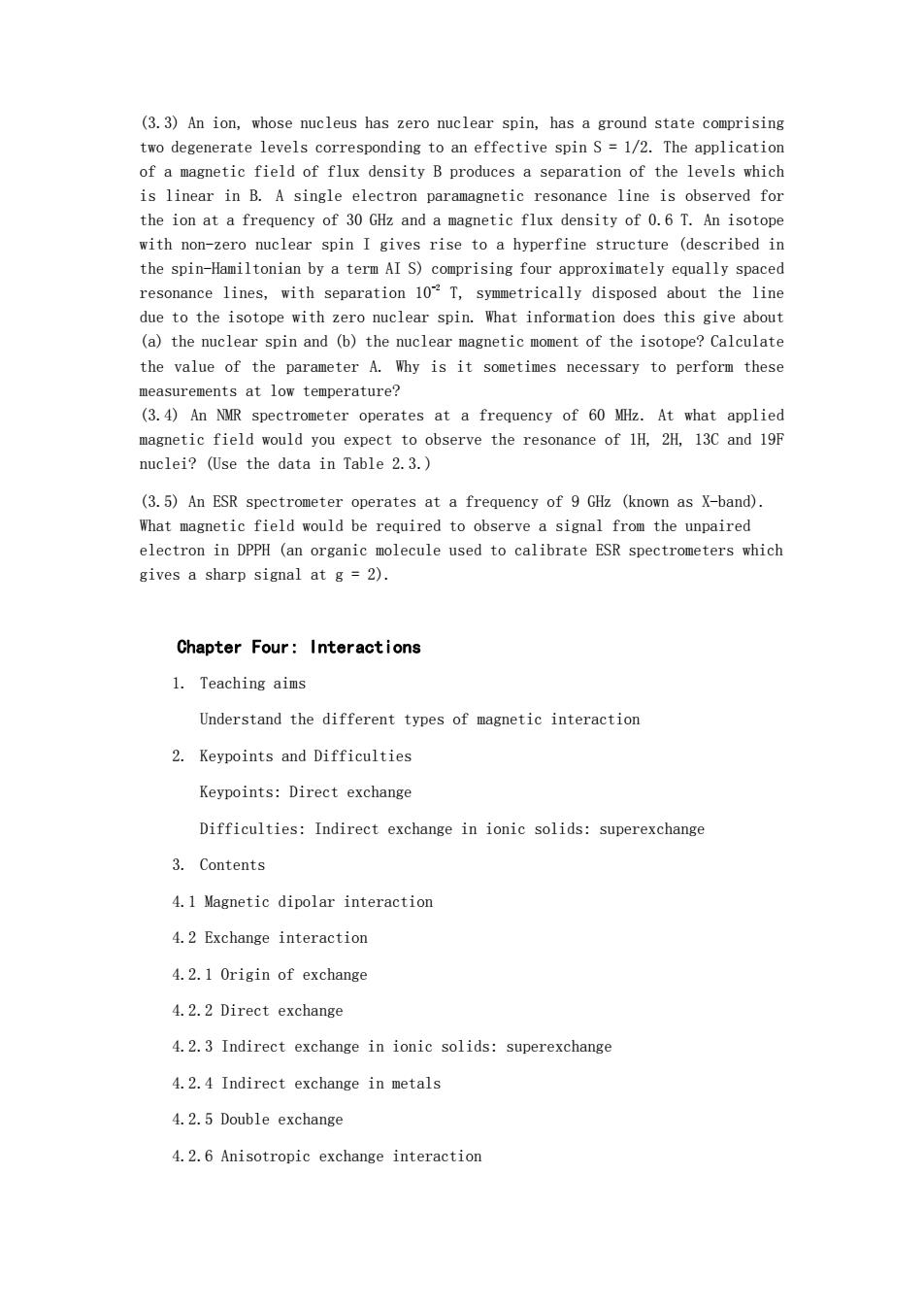正在加载图片...

(3.3)An ion,whose nucleus has zero nuclear spin,has a ground state comprising two degenerate levels corresponding to an effective spin S=1/2.The application of a magnetic field of flux density B produces a separation of the levels which is linear in B.A single electron paramagnetic resonance line observed fo the ion at a frequency of 30 GHz and a magnetic flux density of 0.6 T.An isotope with non-zero nuclear spin I gives rise to a hyperfine structure (described in the spin-Hamiltonian by a term AI S)comprising four approximately equally spaced resonance lines.with separation 10T.symmetrically disposed about the line due to the isotope with ze ronuclear spin.What information does this give about (a)the nuclear spin and (b)the nuclear magnetic moment of the isotope?Calculate the value of the parameter A.Why is it sometimes necessary to perform these measurements at low temperature? (3.4)An NMR spectrometer operates at a frequency of 60 MHz.At what applied to observe the resonance of H,2H,13C and 19F nuclei?(Use the data in Table 2.3.) (3.5)An ESR spectrometer operates at a frequency of 9 GHz (known as X-band). oudbe required to observe a signal fro the electron in DPPH (an calibrate ESR spectrometers which gives a sharp signal at g=2). Chapter Four:Interactions 1.Teaching aims Understand the different types of magnetic interaction 2.Keypoints and Difficulties Keypoints:Direct exchange Difficulties:Indirect exchange in ionic solids:superexchange 3.Contents 4.1 Magnetic dipolar interaction 4.2 Exchange interaction 4.2.1 Origin of exchange 4.2.2 Direct exchange 4.2.3 Indirect exchange in ionic solids:superexchange 4.2.4 Indirect exchange in metals 4.2.5 Double exchange 4.2.6 Anisotropic exchange interaction (3.3) An ion, whose nucleus has zero nuclear spin, has a ground state comprising two degenerate levels corresponding to an effective spin S = 1/2. The application of a magnetic field of flux density B produces a separation of the levels which is linear in B. A single electron paramagnetic resonance line is observed for the ion at a frequency of 30 GHz and a magnetic flux density of 0.6 T. An isotope with non-zero nuclear spin I gives rise to a hyperfine structure (described in the spin-Hamiltonian by a term AI S) comprising four approximately equally spaced resonance lines, with separation 10-2 T, symmetrically disposed about the line due to the isotope with zero nuclear spin. What information does this give about (a) the nuclear spin and (b) the nuclear magnetic moment of the isotope? Calculate the value of the parameter A. Why is it sometimes necessary to perform these measurements at low temperature? (3.4) An NMR spectrometer operates at a frequency of 60 MHz. At what applied magnetic field would you expect to observe the resonance of 1H, 2H, 13C and 19F nuclei? (Use the data in Table 2.3.) (3.5) An ESR spectrometer operates at a frequency of 9 GHz (known as X-band). What magnetic field would be required to observe a signal from the unpaired electron in DPPH (an organic molecule used to calibrate ESR spectrometers which gives a sharp signal at g = 2). Chapter Four: Interactions 1. Teaching aims Understand the different types of magnetic interaction 2. Keypoints and Difficulties Keypoints: Direct exchange Difficulties: Indirect exchange in ionic solids: superexchange 3. Contents 4.1 Magnetic dipolar interaction 4.2 Exchange interaction 4.2.1 Origin of exchange 4.2.2 Direct exchange 4.2.3 Indirect exchange in ionic solids: superexchange 4.2.4 Indirect exchange in metals 4.2.5 Double exchange 4.2.6 Anisotropic exchange interaction